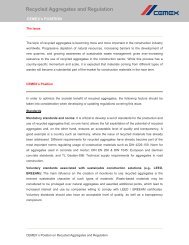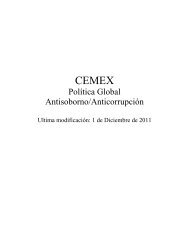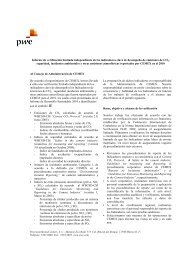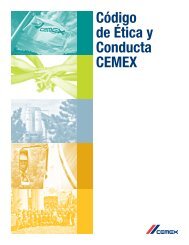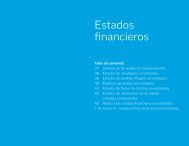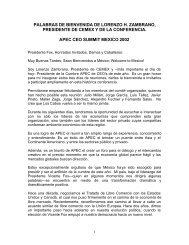building a STRONGER foundation - Cemex
building a STRONGER foundation - Cemex
building a STRONGER foundation - Cemex
Create successful ePaper yourself
Turn your PDF publications into a flip-book with our unique Google optimized e-Paper software.
During the fourth quarter of 2008, the global economic crisis caused financing scarcity in almost all productive sectors, resulting<br />
in a decrease in economic activity in all our markets and a worldwide downturn in macroeconomic indicators. This effect lowered the<br />
overall growth expectations within the countries in which we operate, particularly affecting the construction industry due to the<br />
cancellation or deferral of several investment projects. These conditions, which constitute an impairment indicator, remained during a<br />
significant portion of 2009. During the fourth quarters of 2010, 2009 and 2008, we performed our annual goodwill impairment testing<br />
under MFRS. In 2008, our test coincided with the negative economic environment previously described. For the year ended<br />
December 31, 2008, we recognized goodwill impairment losses under MFRS of approximately Ps18.3 billion (U.S.$1.3 billion), of<br />
which the impairment corresponding to the United States reporting unit was approximately Ps16.8 billion (U.S.$1.2 billion). The<br />
estimated impairment loss in the United States during 2008 was mainly related to the acquisition of Rinker in 2007 and overall was<br />
attributable to the negative economic situation expected in the markets during 2009 and 2010, particularly in the construction industry.<br />
For the year ended December 31, 2009, we did not recognize goodwill impairment losses despite the economic conditions prevailing<br />
during the year, considering that in such period, the main global stock markets started their stabilization and achieved growth as<br />
compared to the closing pricing levels in 2008. Likewise, the reference interest rates at the end of 2009 decreased with respect to their<br />
level in 2008 due to an increase in liquidity in the debt and equity markets, which slightly reduced the risk premium in the countries<br />
where we operate. These elements jointly generated a decrease in the discount rates in 2009 in comparison with the 2008 discount<br />
rates and consequently generated an increase in the value in use of the reporting units. For the year ended December 31, 2010, we<br />
recognized a goodwill impairment loss under MFRS of approximately Ps189 million (U.S.$15 million) associated with our reporting<br />
unit in Puerto Rico, which we acquired in July 2002. See notes 11 and 11B to our audited consolidated financial statements included<br />
elsewhere in this annual report.<br />
As mentioned above, differences between MFRS and U.S. GAAP with respect to the methodology used to determine the final<br />
impairment loss, when applicable, including the selection of key economic assumptions related to the determination of the discount<br />
rates used to assess our assets’ fair value, led to a materially greater impairment loss under U.S. GAAP, as compared to that<br />
recognized in our 2008 consolidated financial statements under MFRS. For the year ended December 31, 2008, we recognized<br />
goodwill impairment losses under U.S. GAAP of approximately U.S.$4.7 billion (compared to U.S.$1.3 billion under MFRS), of<br />
which an estimated impairment loss corresponding to the United States reporting unit was recognized for approximately U.S.$4.5<br />
billion (compared to U.S.$1.2 billion of goodwill impairment losses recognized under MFRS) related to the completion of the second<br />
step required to allocate the fair value of the U.S. reporting unit’s net assets. During 2009, we completed our U.S. GAAP analysis in<br />
connection with the year 2008 impairment exercise and reduced final impairment losses under U.S. GAAP by approximately U.S.$71<br />
million. We did not recognize any additional goodwill impairment losses under U.S. GAAP for the year ended December 31, 2010.<br />
Due to the important role that economic factors play in testing goodwill for impairment, a further downturn in the economies<br />
where we operate could necessitate new impairment tests and a possible downward readjustment of our goodwill for impairment under<br />
both MFRS and U.S. GAAP. Such an impairment test could result in additional impairment charges which could be material to our<br />
financial statements.<br />
Our ability to repay debt and pay dividends depends on our subsidiaries’ ability to transfer income and dividends to us.<br />
We are a holding company with no significant assets other than the stock of our direct and indirect subsidiaries and our holdings<br />
of cash and marketable securities. In general, our ability to repay debt and pay dividends depends on the continued transfer to us of<br />
dividends and other income from our wholly-owned and non-wholly-owned subsidiaries. The Financing Agreement restricts CEMEX,<br />
S.A.B de C.V.’s ability to declare or pay cash dividends.<br />
The ability of our subsidiaries to pay dividends, and make loans and other transfers to us is generally subject to various<br />
regulatory, legal and economic limitations. Depending on the jurisdiction of organization of the relevant subsidiary, such limitations<br />
may include solvency and legal reserve requirements, dividend payment restrictions based on interim financial results or minimum net<br />
worth and withholding taxes on loan interest payments. For example, our subsidiaries in Mexico are subject to Mexican legal<br />
requirements, which provide that a corporation may declare and pay dividends only out of the profits reflected in the year-end<br />
financial statements that are approved by its stockholders. In addition, such payment can be approved by a subsidiary’s stockholders<br />
only after the creation of a required legal reserve (equal to one fifth of the relevant company’s capital) and satisfaction of losses, if<br />
any, incurred by such subsidiary in previous fiscal years.<br />
We may also be subject to exchange controls on remittances by our subsidiaries from time to time in a number of jurisdictions.<br />
In addition, our ability to receive funds from these subsidiaries may be restricted by covenants in the debt instruments and other<br />
contractual obligations of those entities.<br />
We currently do not expect that existing regulatory, legal and economic restrictions on our subsidiaries’ ability to pay dividends<br />
and make loans and other transfers to us will negatively affect our ability to meet our cash obligations. However, the jurisdictions of<br />
organization of our subsidiaries may impose additional and more restrictive regulatory, legal and/or economic limitations. In addition,<br />
our subsidiaries may not be able to generate sufficient income to pay dividends or make loans or other transfers to us in the future.<br />
Any material additional future limitations on our subsidiaries could adversely affect our ability to service our debt and meet our other<br />
cash obligations.<br />
12



